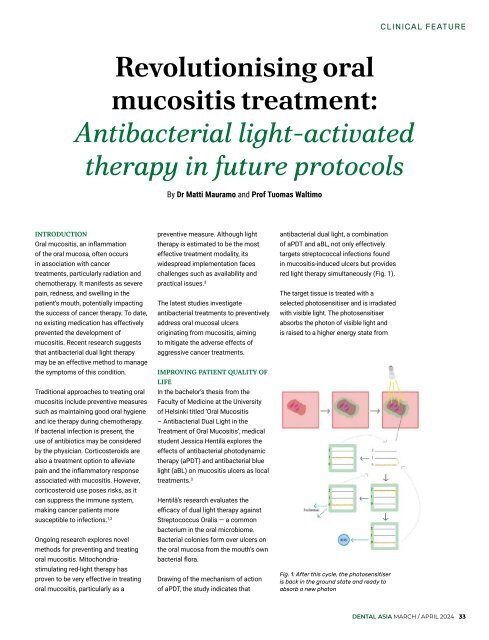Dental Asia March/April 2024
For more than two decades, Dental Asia is the premium journal in linking dental innovators and manufacturers to its rightful audience. We devote ourselves in showcasing the latest dental technology and share evidence-based clinical philosophies to serve as an educational platform to dental professionals. Our combined portfolio of print and digital media also allows us to reach a wider market and secure our position as the leading dental media in the Asia Pacific region while facilitating global interactions among our readers.
For more than two decades, Dental Asia is the premium journal in linking dental innovators
and manufacturers to its rightful audience. We devote ourselves in showcasing the latest dental technology and share evidence-based clinical philosophies to serve as an educational platform to dental professionals. Our combined portfolio of print and digital media also allows us to reach a wider market and secure our position as the leading dental media in the Asia Pacific region while facilitating global interactions among our readers.
Create successful ePaper yourself
Turn your PDF publications into a flip-book with our unique Google optimized e-Paper software.
CLINICAL FEATURE<br />
Revolutionising oral<br />
mucositis treatment:<br />
Antibacterial light-activated<br />
therapy in future protocols<br />
By Dr Matti Mauramo and Prof Tuomas Waltimo<br />
INTRODUCTION<br />
Oral mucositis, an inflammation<br />
of the oral mucosa, often occurs<br />
in association with cancer<br />
treatments, particularly radiation and<br />
chemotherapy. It manifests as severe<br />
pain, redness, and swelling in the<br />
patient’s mouth, potentially impacting<br />
the success of cancer therapy. To date,<br />
no existing medication has effectively<br />
prevented the development of<br />
mucositis. Recent research suggests<br />
that antibacterial dual light therapy<br />
may be an effective method to manage<br />
the symptoms of this condition.<br />
Traditional approaches to treating oral<br />
mucositis include preventive measures<br />
such as maintaining good oral hygiene<br />
and ice therapy during chemotherapy.<br />
If bacterial infection is present, the<br />
use of antibiotics may be considered<br />
by the physician. Corticosteroids are<br />
also a treatment option to alleviate<br />
pain and the inflammatory response<br />
associated with mucositis. However,<br />
corticosteroid use poses risks, as it<br />
can suppress the immune system,<br />
making cancer patients more<br />
susceptible to infections. 1,2<br />
Ongoing research explores novel<br />
methods for preventing and treating<br />
oral mucositis. Mitochondriastimulating<br />
red-light therapy has<br />
proven to be very effective in treating<br />
oral mucositis, particularly as a<br />
preventive measure. Although light<br />
therapy is estimated to be the most<br />
effective treatment modality, its<br />
widespread implementation faces<br />
challenges such as availability and<br />
practical issues. 3<br />
The latest studies investigate<br />
antibacterial treatments to preventively<br />
address oral mucosal ulcers<br />
originating from mucositis, aiming<br />
to mitigate the adverse effects of<br />
aggressive cancer treatments.<br />
IMPROVING PATIENT QUALITY OF<br />
LIFE<br />
In the bachelor’s thesis from the<br />
Faculty of Medicine at the University<br />
of Helsinki titled ‘Oral Mucositis<br />
– Antibacterial Dual Light in the<br />
Treatment of Oral Mucositis’, medical<br />
student Jessica Hentilä explores the<br />
effects of antibacterial photodynamic<br />
therapy (aPDT) and antibacterial blue<br />
light (aBL) on mucositis ulcers as local<br />
treatments. 3<br />
Hentilä’s research evaluates the<br />
efficacy of dual light therapy against<br />
Streptococcus Oralis — a common<br />
bacterium in the oral microbiome.<br />
Bacterial colonies form over ulcers on<br />
the oral mucosa from the mouth’s own<br />
bacterial flora.<br />
Drawing of the mechanism of action<br />
of aPDT, the study indicates that<br />
antibacterial dual light, a combination<br />
of aPDT and aBL, not only effectively<br />
targets streptococcal infections found<br />
in mucositis-induced ulcers but provides<br />
red light therapy simultaneously (Fig. 1).<br />
The target tissue is treated with a<br />
selected photosensitiser and is irradiated<br />
with visible light. The photosensitiser<br />
absorbs the photon of visible light and<br />
is raised to a higher energy state from<br />
Fig. 1: After this cycle, the photosensitiser<br />
is back in the ground state and ready to<br />
absorb a new photon<br />
DENTAL ASIA MARCH / APRIL <strong>2024</strong> 33

















